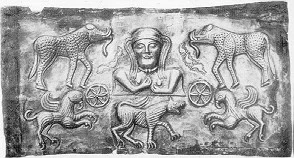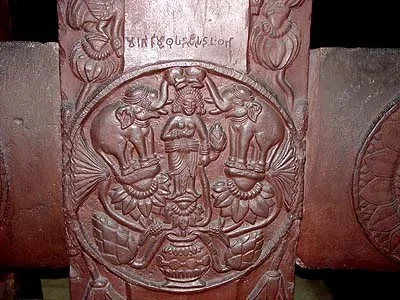
Picture shows Gajalakshmi in Gundestrup silver cauldron
(This is the fifth part in my thesis to prove that Kalidasa lived before Sangam Tamil period. Kalidasa’s date was around 1[SUP]st[/SUP] century BC. Tamil poets have used a lot from his 1000+ similes in various places. For some of these we may find a common source. But a lot of similes and idioms and phrases show beyond any shadow of doubt that they knew Kalidasa’s works and they deliberately used them in Sangam Tamil poems. Art Historian Sri C Sivaramamurti and others used different methods to arrive at the same date of first century BC. Sivaramamurti showed how Junagadh Rudradaman inscription of second century AD had echoed Kalidasa’s poems)
Lakshmi is praised by various Tamil and Sanskrit poets from Vedic days. They used the words THIRU (Tamil) and SRI (in Sanskrit) to mean wealth as well as Goddess Laksmi. Goddess Lakshmi is in charge of wealth. There are innumerable references to the goddess in Tamil and Sanskrit works. But the interesting form of Lakshmi is GAJA LAKSHMI(Gaja in Sanskrit means elephant). Goddess Lakshmi seated on a lotus flower and two elephants on either side pouring water on her is known as Gaja Lakshmi. This particular aspect of Lakshmi is considered very auspicious. In India, particularly in Chettinadu of Tamil Nadu, palatial houses have Teak doors with the wooden figures of Gajalakshmi till this day.
Gajalakshmi’s figures have travelled from the Himalayas to the southern most part of Sri Lanka. It is in the form of old coins, lamps, wooden figures, idols and stone sculptures. It has travelled from India to Denmark !! We have Gajalakshmi figure carved in to Gundestrup silver Cauldron. Now it is in Copenhagen. When they dug up a marshy area in Jutland , Denmark in 1891 they recovered a big silver vessel which is dated to second century BC. A very interesting fact about this vessel is that there is a god surrounded by animals like we see in the Indus valley seal (For more details please read my article Vishnu in Indus Valley Seal)
The earliest reference to Gajalakshmi is in Sri Suktam of the Vedas:
“Laksmir –divyair-gajendrair-manigana-kasithai: snabitha hemakumbhair nithyam sa pathma hastha”
(Holding a lotus in hand she is bathed by water from the gem studded golden pot by the celestial elephants)
Later Valmiki, Kalidasa and Sangam Tamil poets described the goddess in detail. We get lot of materials with the figure in coins, sculptures, idols etc. from second century BC onwards .The Bharhut sculptures show a beautiful Gajalakshmi which is in Kolkatta museum at present. Ellora, Mahabalipuram cave temples also have got these sculptures.
Gajalakshmi coins are in plenty belonging to different dynasties of different periods. The oldest coin was issued by an Indo Greek king Azilises of North West India in first century BC. Later kings of Kosambi and Mathura Bijaasata Mitra and Visaka Deva respectively issued coins with Gajlakshmi. In Sri Lanka we find Gajalakshmi on the coins of 1[SUP]st[/SUP] century AD. The coins were recovered from Anuradhapuram,Kantharodai , Manthottam in Sri Lanka and Karur of Tamil Nadu.

Buddhists and Jains “worshipped”
Not only Hindus but also the Jains and Buddhists respected or probably worshipped Gajalakshmi. The Buddhist kings of Sri Lanka issued such coins. Bharhut sculpture of Gakjalakshmi is another proof for it. Jain Tirthankar Mahavir’s mother Trishala had a dream of 14 auspicious signs before the birth of Mahavir. The fourth dream was of Gajalakshmi.
Michael Michener read a paper at a seminar in British Museum, London where he listed all the old kings who issued coins of Gajalakshmi. The list includes coins of Indo Greek king Azilesas, Mathura King Raju vula , Andhra King Shrive Satakarni(1[SUP]st[/SUP] century) ,Jayanagar (8[SUP]th[/SUP] century AD) and Nayak Kings of Tamil Nadu.
In the 2000 year old Sangam literature, we have references in the books:
Nedunal vaatai .88-89 and Kalitokai 44-8.
Madurai Kanchi of Mankudi Maruthan 353
Kapilar being a Brahmin well versed in Sanskrit used lot of Kalidasa’s similes and expressions. In Kalitokai, Kurinji Kali 44-8 he described Gajalakshmi.
Another Brahimn poet Nakkirar, who would have read all Kalidasa in Sanskrit used a lot of Kalidasa’s works on Muruga (Lord Skanda) in his Tirumurukatruppatai and Lakshmi in Nedunalvatai.
“Have massive door posts daubed with ghee and white mustard
And held by a stout lintel named after Uttara star,
Where on are carved the figures of Goddess Lakshmi,
With the elephants holding water lilies on either side
And fitted with double doors, iron clamped..... (Nedu88-89)
(Nachinarkiniyar interpreted these lines as Gajalakshmi. English translation is based on his commentary. Arthasastra also advised kings to install such figures in the fort doors)
In Sivaka Sinthamani (2595), we see the same picture.
In Kalidasa we have references to Gajalakshmi in the books:
Raghuvamsa 12-93: Kalidasa was describing the battle between Rama and Ravana with beautiful similes in every sloka/couplet. The commentators struggled to comment on this sloka because they did not know what he was using as simile. They guessed that a wooden plank with wheels was used when two elephants clashed in the battle field. But anyone who reads it can easily see he used Jayalakshmi (goddess of victory) in between two elephants to mean Galjalakshmi .
In Meghadutam 79, Kalidasa described the lotus and conch (Sangha Nidhi and Padhma Nidhi) pictures drawn on the doors. They are considered two of the nine treasures of Kubera. Saivite saint Appar also mentioned these treasures of Kubera in his Thevaram hymns.
Arthasastram of Kautilya (second century BC) listed several gods and goddesses to be installed in the forts and Gajalakshmi was one of them
Tamil References:
குறிஞ்சிக் கலி
வரிநுதல் எழில் வேழம் பூநீர் மேல் சொரிதரப்,
புரிநெகிழ் தாமரை மலரங்கண் வீறு எய்தித்,
திரு நயந்து இருந்தன்ன தேங்கமழ் விறல் வெற்ப! (கலி.44-8-5/7)
மதுரைக் காஞ்சி
விண் உற ஓங்கிய பல் படைப் புரிசை
தொல் வலி நிலை இய அணங்குடை நெடி நிலை(352-353)
நெடுநல்வாடை
ஐயவி அப்பிய நெய் அணி நெடு நிலை
வென்று எழு கொடியொடு வேழம் சென்று புக
குன்று குயின்றன்ன ஓங்கு நிலை வாயில்
திருநிலை பெற்ற தீது தீர் சிறப்பின் (86-89)
அப்பர் தேவாரம்
சங்க நிதி பதும நிதி இரண்டும் தந்து
தரணியொடு வானாளத் தருவரேனும்
மங்குவார் அவர் செல்வம் மதிப்போம் அல்லோம்
மாதேவர்க்கு ஏகாந்தர் அல்லார் ஆகில் (அப்பர் 6-346)
References
1. The Gundestrup Cauldron by Timothy Tailor-Scientific American, March 1992
2. Ancient coins of India by A. Cunningham (pages 74,86,92 and 100)
3. Foreign influence on Ancient Sri Lankan Coinage by Jayasinghe-1997
4. Lakshmi bathed by elephants on ancient Indian coins by Michael Michener-seminar in British Museum-2-12-2000
